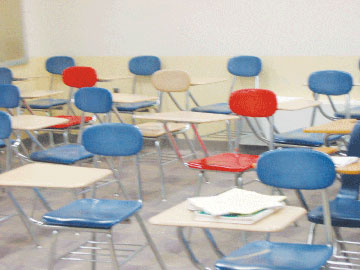With Low Enrollment, Fewer Spring Classes Expected

John Kane
A decline in enrollment is a main factor in forcing administrators to cancel classes for next semester.
December 17, 2004
In anticipation of low enrollments next semester, senior administrators and college officials are seeking to cancel sections of classes.
A five percent decline in enrollment and a potential $1.5 million dollar shortfall in the instructional budget have the university’s six colleges looking to cancel under-enrolled classes, with the hopes of saving money and balancing out the number of courses and the number of students in them.
“Things have gotten a little bit out of alignment,” said College of Liberal Arts Dean Donna Kuizenga.
Provost Paul Fonteyn has charged the deans of the six colleges with taking a closer look at under-enrolled classes, with Dean Kuizenga, who arrived from the University of Vermont last summer, taking the lead.
“It’s standard operating procedure,” said Fonteyn said of the cancellations. He noted that the number of courses and the number of students in them has not been monitored as closely as it should have been in recent years. Undergraduate courses should have a minimum of twelve students, with graduate courses required to have a minimum of eight, Academic Affairs officials say.
Some exceptions will be made for students who need a course to help graduate, officials added.
But if colleges continue to hold large numbers of under-enrolled courses, officials say it could potentially lead to a $1.5 million dollar shortfall in the instructional budget. Since money is allocated each year to pay for part-time professors, they say, if under-enrolled courses continue to be offered, the university could possibly lose money by having to pay for both a full-time professor and a part-timer.
“If we follow this down the slope, we could have a liability of 1.5 million,” said Fonteyn. “I want to make sure that doesn’t happen. And one way to help that not happen is by monitoring under-enrolled classes.”
The College of Liberal Arts, which contains the lion’s share of courses on campus and remains responsible for the most students, is expected to bear the brunt of the cuts. The total number of cancellations from CLA and the other colleges could not be obtained, since administration officials say it’s too early to give an exact figure. The College of Nursing and the College of Science and Mathematics may not be affected as much due to steadier enrollments, Academic Affairs officials say. College of Public and Community Service (CPCS), which college officials say is used to dealing with cuts due to enrollment, is not expected to be greatly impacted.
Close monitoring of under-enrolled courses will continue into the spring. “We will also be doing an audit of low enrollment courses this Spring and if we conclude that your college has not addressed this problem, we will take this into consideration during this next budget cycle,” Fonteyn wrote in a memo to college deans, who he says are fiscally responsible for their college.
In CLA, the English Department, the largest department, is expected to be the hardest hit with cancellations across twelve courses. Department chair Robert Crossley said the cuts were equally distributed, from freshman composition courses, day and night classes, and upper division courses. Kuizenga has left it up to department chairs to decide which courses get cut, saying she doesn’t want to “micro-manage” the situation and the department chairs know best which ones to cut.
“The real problem is to get student enrollment back up,” said Crossley. But with tuition and parking costs on the rise, “we’re cutting into our student base,” he added. “We’re trying every possible thing” to up enrollment, said Fonteyn, adding that it’s one of three topics discussed in nearly all top meetings. “Enrollment’s everybody’s business.”
The Political Science Department, initially planning to cancel eight sections, was able to pare it down to five. Inserted in booklets detailing spring semester courses, a yellow slip of paper told students, “In selecting the sections to cancel, we have tried to choose whose loss would cause the least inconvenience for our students, but we do realize that some students will encounter difficulties because of these changes, and we apologize for any inconvenience or hardship you encounter.”
Psychology Department chair Steven Schwartz had already cut a half dozen in response to the fall’s low enrollment, before two more, out of 60 sections, were requested from Kuizenga.
The department is somewhat atypical, said Schwartz, since it has so many majors that it has multiple sections of their many undergraduate courses, “whereas a lot of departments, except for their introductory class, have only one section.”
Schwartz says he suspects it varies with the size of the department. “Since we’re the largest major, we tend to offer multiple sections of many of our undergraduate courses,” he said.
Kuizenga is using a special formula for determining the number of classes that need to be canceled, which includes looking at the number of students enrolled in a department a year ago, and adding twenty percent for wiggle room.
The number of cancelled classes is not a reflection of a department’s lack of success, said Kuizenga. “It’s not about that,” she said. “It’s about right-sizing things.”





















































